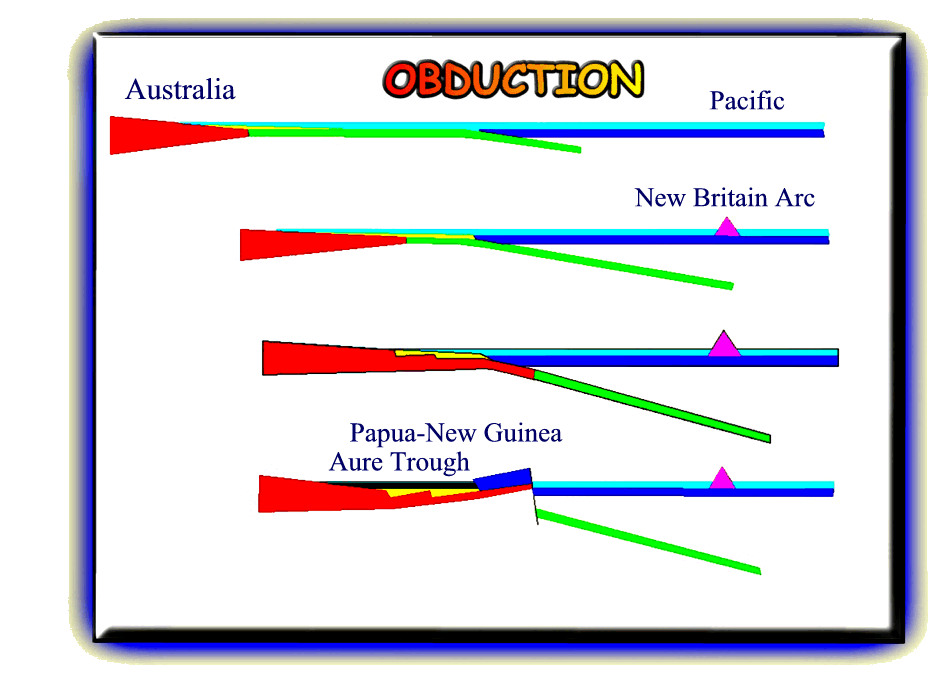Go to 'figures/overhead' section.
OBDUCTION
Ultramafic-mafic (ophiolite) complexes of the kind
discussed in the lecture on the structure of oceanic crust, all lie above
continental crust located adjacent to the continent-ocean interface. Emplacement
of the supposed oceanic material is thought to have resulted from the attempted
subduction
of continental crust beneath oceanic crust along slip surfaces dipping
towards the ocean. This process is known as obduction.
Because continental crust is less dense and more buoyant than oceanic crust,
the former will eventually rise leaving the oceanic material stranded on
the continental margin.
In some cases, the oceanic slab may migrate under
the influence of gravity towards the continental interior, causing the
development of a foreland basin (also known
in the older literature as an exogeosyncline) between the obducted oceanic
crust and the continental interior as a result of the depression of the
continental margin. The sediments deposited in the basin will include turbidite
material of both continental (e.g. K-feldspar; muscovite)
and oceanic (e.g chromite) derivation. As the ophiolite migrates
landward it overrides its own debris, which is converted to an olistostromal
melange composed of blocks of sandstone and ophiolite material in
a scaly textured fine-grained pelitic material.
A classic Canadian example of obduction and foreland
basin development is represented by the Bay of Islands
ultramafic - mafic complex and underlying sedimentary units of Western
Newfoundland. (see also :
http://publish.uwo.ca/~wrchurch/300/westnewf/Newfpaper1-13.pdf
http://publish.uwo.ca/~wrchurch/300/westnewf/NewfPaper14-26.pdf
Other regions which contain good examples of obducted
oceanic crust include the Canadian Cordillera,
Oman
in the Persian Gulf area, and Papua-New Guinea
in the Pacific. The ophiolites referred to in geosynclinal theory (e.g.
the Alpine system) and early plate tectonic
scenarios (e.g. Dietz's miogeoclinal model) represent obducted oceanic
crust. In this case, eugeosynclines would be foreland basins, and the 'flysch'
of eugeosynclines would represent sediment derived from the overriding
oceanic material and the older continental-derived slope and rise sediments
that were dragged back onto the continent by the migrating oceanic slab.
The zwischengebirge zones of geosynclines
therefore mark the locus of obduction, and subsequent continent-continent
collision.
The Straits of Belle Isle separating Newfoundland
from Labrador in the distant background. Rocks in the foreground are undeformed,
flat-lying Cambro-Orodovician shelf carbonates. (Bob Stevens is the
geologist sitting on the log of wood.)
Cross-bedded Cambrian shelf sandstones
(Chickies Formation of Pennsylvania); early passive margin sediments of
the Appalachian Iapetus ocean.
Ordovician 'Lime' turbidites: slope
and rise deposits dragged over the edge of the continent during obduction
of the Bay of Islands ophiolite.
Melange beneath the Bay of Islands ophiolite
(Iapetus) of Western Newfoundland.
'Argille scagliose' (scaly shales) melange
associated with obducted ophiolite of the Alpine system of Macedonia I.
'Argille scagliose' (scaly shales) melange
associated with obducted ophiolite of the Alpine belt of Macedonia II.
Olistostromal melange exposed on the banks
of the St. Laurence near Quebec City (St Aubin).
Ordovician melange with blocks of pillow
lava, carbonate and 'eclogite', located below the Ballantrae ophiolite
(Iapetus) of Scotland.
Overhead sequence:
The Obduction model. (12obdmod.gif)
Obduction - world distribution of ophiolites;
Obducted ophiolite. (09ophloc.gif)
The Cordilleran geosyncline Cordilleran zones and obduction. (12ncord.gif)
Map of the Newfoundland Appalachians. (09nfdlnd.gif)
The Cambrian rift margin.
The stratigraphic history of the Western Margin of the Appalachians
(R.K. Stevens). (12wstmwf.gif)
The rift stage of the Appalachian continental margin (R.K. Stevens).
(12wnfdob.gif)
Stevens' Western Newfoundland bulldozer obduction model (R.K. Stevens).
(12wnfdob.gif)
FIGURES
Distribution of ophiolites.
Early explanation for the structural emplacement
of Alpine ophiolites (see Ciorneva).
The obduction model.
Geological map of the Persian Gulf
region showing the location and size of the Oman ophiolite; thrust southwards
out of the Persian Gulf onto the northern edge of the Arabian Shield.
The geology of the northern Canadian Cordillera.
Geological Map of Newfoundland
The Bay of Islands ophiolite of Western Newfoundland.
The rift stage of the Appalachian continental
margin (R.K. Stevens, 1969).
The bulldozer obduction model (R.K. Stevens,
1969).
Stratigraphic history of the Western Newfoundland
Foreland Basin (R.K. Stevens, 1969).
Return to beginning.
Click here to return to course outline.
Return to course
list.
